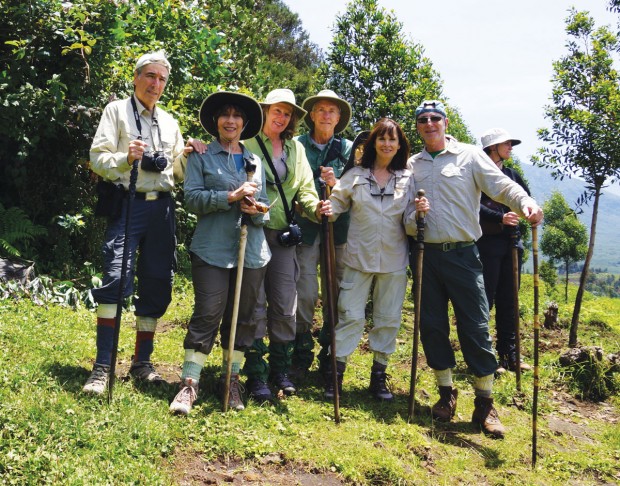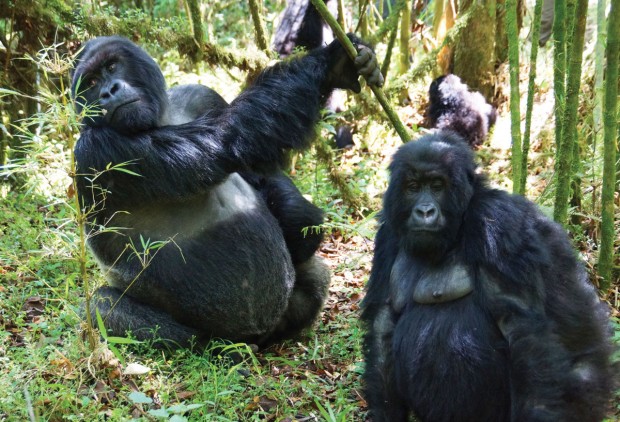On safari: the circle of life


Houston travelers tracked and shot their quarry with cameras instead of guns. Len and Carol Hershkowitz, Marilee and Marty Steiner, and Linda and Ronny Abramson (from left) had an exhilarating immersion with mountain gorillas in Rwanda.
Lions stalking their prey or nursing their young, coats glistening in the noonday sun of the Serengeti plain. Herds of zebras grazing in the wake of the wildebeests – hundreds of thousands of wildebeests. Standing breathless in the midst of the Rwandan jungle, surrounded by a family of mountain gorillas.
Safari is an unforgettable experience for those lucky enough to embark upon such an adventure, and it’s one that’s likely to leave travelers deeply moved, and with a greater appreciation of nature at its most magnificent.
Three Buzz families embarked on such an adventure a year ago, and the memory still brings a smile to their faces.
Neurologist Marty Steiner had already been on safari twice, but had talked with friends who had traveled to Rwanda to see the mountain gorillas in their natural habitat, and their stories caught his attention. His wife Marilee, a recruiter and former psychologist, had always wanted to go to Tanzania, so they decided to combine the two trips in one. Marilee’s parents were tour operators, and so she did the research, together with her friend Carol Hershkowiz, finding an operator who could guide them through both experiences.
The Steiners teamed up with local businesspeople Ronny and Linda Abramson and Carol and Lenny Hershkowitz, also a neurologist, beginning with the trip to Rwanda to see the mountain gorillas. “It brings tears to my eyes at this very moment,” began Marilee, visibly moved at the memory. “It was really one of the highlights of my life seeing them.”
Visiting the mountain gorillas is not a small thing. First you have to get the permit, which is a challenge in itself; the Rwandan government strictly controls access to the 10 mountain gorilla families that range through the forests of Rwanda, Uganda and the Congo, and with good reason: the Gorilla beringei graueri is only found in Rwanda and is one of the rarest species of gorilla in the world. Indeed, the Rwandan government’s careful and community-based management of gorilla tourism has led the United Nations Environmental Programme to highlight it among its “success stories.”
Only 80 people a day can go up, or 10 groups of eight. They meet with their guides at 6 a.m., ready for a difficult climb and encounters with ankle-deep mud, tropical rainstorms, stinging nettles and biting insects. Worst of all, there is no guarantee that you will see the gorillas at all. The Houston group was lucky.
“We were prepared with chaps for our feet and gloves and walking sticks,” said Marilee. “It turned out to be a gorgeous day. I kept asking, ‘When do I have to put the gloves on?’ We never needed them because our gorilla group wasn’t in that area.”
As Linda recalls it, less than an hour into the hike, the guide turned to them and said, “Can you smell?” Indeed there was suddenly a faint odor. They had caught up with the Agashya group, one of the largest, with 23 members. “They were sitting there, eating bamboo, picking their teeth,” recalls Ronny. “They surround you when you’re with them – you’re just 3 feet to 10 feet away from them.”
“They’re just such gentle giants,” added Linda. “They’re looking at us, and we’re looking at them, and everyone has their cameras up.”

The Houston travelers saw one of the largest mountain gorilla families, one of 10 that range the jungles of Rwanda, Uganda and the Congo. This is Agashya with part of his family. (Photo: Ronny Abramson)
Marty was taking a photo of one and suddenly a baby ran up behind him and grabbed his leg, using it as a pivot point to twirl around and run back behind Linda. The mother very gently placed her hands on Linda’s shoulders and moved her aside to reach her baby.
“It was somewhat of an exhilarating experience,” said Marty. “I had never been touched by a gorilla before.”
Perhaps even more moving but in a very different way was their interaction with the Rwandan people. Twenty years after one of the most brutal genocides in world history, the country has undergone a reconciliation process and a profound transformation. The Steiners and the Abramsons were struck by the careful stewardship of the natural resources, the attention to cleanliness – litter was virtually nonexistent – and the kindliness of the Rwandan people. A visit to the Kigali Genocide Memorial Centre, a museum exploring the story of the Rwandan genocide, was especially powerful.
Their trip took place at the height of the Ebola epidemic – a phenomenon that caused fear back home, but the Steiner crew headed on, unfazed. “It was 4,000 miles away, on the other side of the continent,” said Marty, dismissing the danger – but taken aback by the complete lack of screening when they arrived home at the airport, a stark contrast to the extensive health screenings throughout their Africa tour.
After their Rwanda tour they boarded a plane for Nairobi, Kenya, where they caught a transfer to Arusha, Tanzania, the jumping-off point for their trips to the Serengeti National Park and Ngorongoro Conservation Area. They were able to witness a part of the Great Migration – an amazing spectacle revolving around the annual migration of about 1.5 million wildebeests, or gnus, followed by about 300,000 zebras. The wildebeests eat the higher part of the grass, as Marty explained, while the zebras follow along behind and eat the lower part. Following them both are a variety of predators – lions, cheetahs, hyenas and wild dogs – increasing the likelihood of witnessing a kill. Normally the migration happens in December, but climate change makes this phenomenon less predictable, and when the Houston travelers arrived in October, they were right on time.
The wildebeest start the whole chain of events when they mate near the Ngorongoro Crater, then begin a circular sojourn through the Serengeti then north to Kenya, circling back to the Ngorongoro to give birth.
“The animals that prey on the wildebeest follow along, so it’s the whole circle of life – and we were able to become a part of that,” said Marty.
Witnessing the animals in their natural habitat is like nothing you will experience outside of a safari, said Marty. “You see them and they look entirely different from when they’re in the zoo,” he said. “You see these animals in captivity, with shabby coats that don’t have a shine or glisten to them – when you see them in their natural habitat, they are magnificent animals; they look so clean with their cubs or their offspring – they look amazing.”
The other amazing experience was to be there in the midst of mating lions, listening to their calls at night during the mating process, which takes place about every 15 to 20 minutes for seven to eight days, around the clock.
“As the male is mating you hear these roars and sounds that are made; through the night you could hear it going on while you were trying to sleep.”
The Steiners particularly recall a moment when they were all looking off to the left at some animal activity going on. Marilee was sitting on the right side of the car and happened to look out the window.
“Under this bush we’re parked next to is a female lion. Had she stepped out of the car she’d have been right in the lion’s face,” said Marty. “You’re admonished never to leave the safari vehicle. Now we know why.”
The other great part of the trip, he added, was traveling with good friends. Six people is the ideal number to travel with on safari because each vehicle holds six people plus the driver. “So this reduced the expense, and it was very comfortable,” said Marty. “We had a seat rotation system, and everyone felt amicable… we had a lot of fun.”
The only down side, said Marilee, a bit ironically, is that “When you do something like this, it’s just impossible to raise the bar.” Speaking from a nice hotel after dinner in Milan, Italy, with their travel buddies the Abramsons, the couple traded safari memories with alacrity. Italy barely scored a mention. “We’re having trouble thinking of another trip,” joked Marilee, “because we can’t imagine anything that would top that.”
Safari tips from the Steiners
Take Turkish Airlines direct to Istanbul and plan a layover of a day or two – or three – to take in the sights. The Abramsons and the Hershkowitzes scheduled three days in the ancient city. The Steiners had already seen Istanbul and opted instead for a tour of Cappadocia, where they floated in a hot air balloon over a fairyland marked with homes carved into geological chimneys, pillars and cones.
If it’s gorillas you crave, try The Safari Partners. Their guide, Chris Ronneseth ([email protected]), organized the whole Africa portion of the tour, from Rwanda to Tanzania, lined up the gorilla trek permits and provided a seamless experience.
If people want to do a safari on a budget, try Overseas Adventure Travel. Their lineup includes a Tanzania safari starting at $2,995. Marty Steiner used them for a Botswana-Namibia-Zimbabwe tour and considers them reasonably priced and good quality.
Further reading
Rwanda:
On the gorilla protection and community tourism programs http://www.theguardian.com/global-development/2014/jul/28/rwanda-gorillas-community-tourism
Tanzania:
Want more buzz like this? Sign up for our Morning Buzz emails.
To leave a comment, please log in or create an account with The Buzz Magazines, Disqus, Facebook, or Twitter. Or you may post as a guest.


